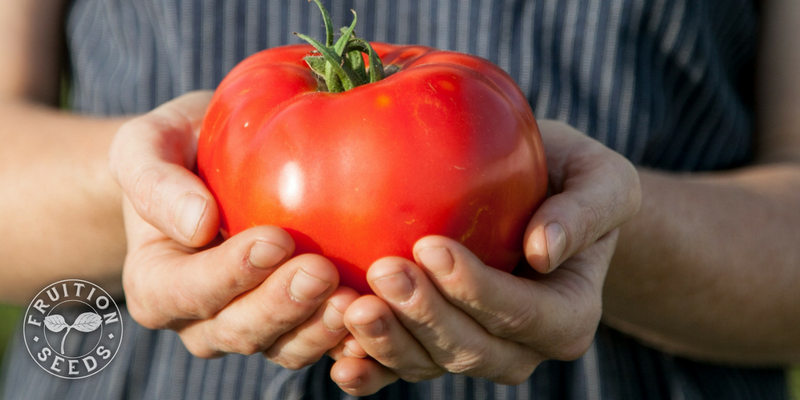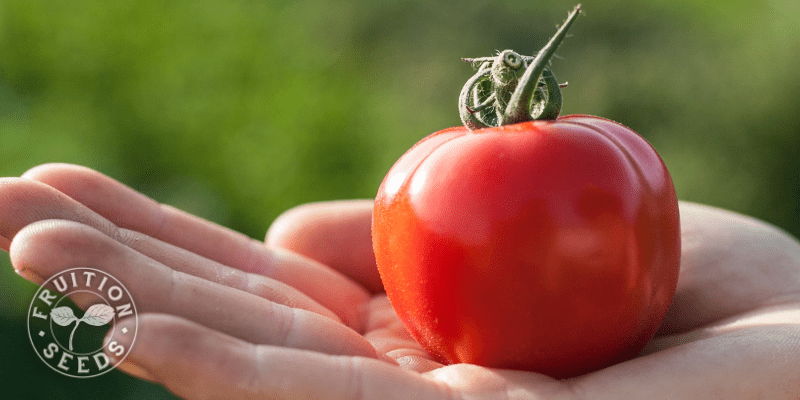If you’d love to save tomato seeds, we love you!
It’s fabulously simple and you definitely don’t need to hand-pollinate them — here are 7 Steps to Saving Tomato Seed for you, Friends!
If you’re interested in making your own crosses or even F1 Hybrids, dive into the video above for deeper detail on the actual hand-pollination process and below you’ll find some musings on the the big ‘why’ of it all as well as a bit of the how.
Much Ado About F1 Hybrids
Words — even letters — are powerful. Hybridization with a lower-case ‘h’ has occurred naturally for 400 million years while the F1 Hybrid with an upper-case ‘H’ emerged around WWI. F1 Hybrids are the first generation (first filial generation = F1) of very deliberate and distinct parents.
Though the F1 generation is incredibly uniform, the second (F2!) generation of seed expresses much more diversity, often looking astonishingly different from the F1 generation. Farmers return to purchase F1 Hybrid seed season after season. And though GMOs get a bad rap for patenting life (deservedly), we would do well to apply such critiques also to most parent lines of F1 Hybrids that are proprietary ‘intellectual property,’ many are patented and virtually none are publicly available.
Here is where I confess: for decades I appreciated the reliability possible in F1 Hybrids though patenting, and proprietary relationships with seeds deeply troubled me. Further confession: this is still true! Also true: the parent lines of F1 Hybrids needn’t be inbred and certainly not patented.
As we compost binary thinking around Hybrids, we realize it is possible to create deliciously disease-resistant F1s with publicly available parents that are not solely inbred. We also recognize that disease-resistant F1 Hybrids are impressively capable as well as nimble tools in our collective toolbox, especially as climates change. Considering that stabilizing genetic resistance in an open-pollinated variety takes at least six if not ten generations or more, we found ourselves making crosses to explore creating F1 Hybrid tomatoes with delicious disease resistance.
A Tale of Two Tomatoes
We are immensely grateful here in the Northeast to have public plant breeders creating resilient varieties for our short seasons.
One of these public plant breeders, Martha Mutschler-Chu, recently retired from several decades of developing disease-resistant tomatoes at Cornell University.
In 2013, the variety ‘Iron Lady’ was released from her program, becoming the first F1 Hybrid tomato with ‘triple resistance:’ actual resistance to Late Blight, Septoria Leaf Spot and tolerance of Early Blight. (Though Iron Lady is Solanum lycopericum, disease resistance from S. pennellii had been crossed into one of the parent lines.) Though tasting better than a standard grocery store tomato in January, the lack of richness and depth of flavor left many growers still wanting better options.
We were among the people wondering what might happen if Martha’s triple-resistant tomato lines were crossed with the beloved heirloom ‘Brandywine:’ would triple resistance and flavor pair in the resulting F1 Hybrid?
They did!
We immediately started making the cross to save and share the seeds of ‘Brandywise,’ an indeterminate, large red slicer with the best of both worlds: succulent flavor and resistance to Late Blight and Septoria as well as Early Blight tolerance. We’ve been sharing these seeds since 2018 and if you’d love to see how we make the crosses — and how you can, too! — enjoy the video above. It’s really quite simple and so much fun; you’ll likely never look at tomatoes the same.
After the revelation of Brandywise, we asked to play with one of Martha’s triple-resistant lines, hoping to find another cross whose fruit would produce another disease-resistant and uniquely delicious tomato. We fell in love with a cross between Martha’s line and Will Bonsall’s Gardener’s Sweetheart, a heart-shaped red cherry exceptionally sweet and creamy. The resulting ‘Summer Sweetheart’ is a large two-bite cherry tomato with handsome ribs scrumptious in salads, roasted and stuffed with mozzarella.
And Friends, these two F1 Hybrids are technically ‘top crosses.’ Rather than the two parents being inbred lines, one is inbred (CU-79) and the other is more genetically diverse. If you’ve grown Brandywine, you know not all the plants are identical, though they all are delicious; as a result, Brandywise plants are not exactly identical, though they are still a fabulously consistently red, splendid slicer with impressive disease resistance.
Sow Seeds & Sing Songs,

& the whole Fruition Crew



Amazing! And very informative. Thank you.
I am having a horrible time with tomato blight. I grow mostly Heirlooms with a few hybrids, mostly of the Better groups. Cherokee Purple is my favorite tomato of all. The only treatment I have not tried is the Apple Cider Vinegar approach. (Planned for next year.) I get about a two week harvest and after that just destroy the plants and wait for next year.
Summer Sweetheart sounds like a tomato that I need to try. How can I obtain seeds? I promise a full report. My growing area is 7B Raleigh, NC.
Butch Horton
Butch,
sorry to hear of your tomatoes. You can still order seeds on our website until late August.